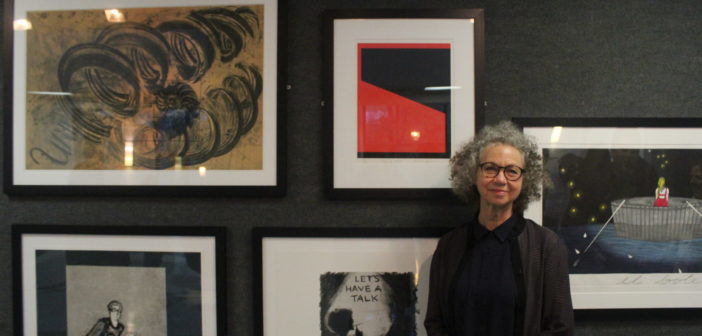The Lehigh University Art Gallery (LUAG) exhibit, “The Future Is Female,” centered on the engagement of women artists in printmaking, drew an intimate crowd at a gallery talk on Oct. 18 in Rauch Business Center.
The exhibit, which celebrates contemporary women artists in the galleries’ permanent collection, is a timely dialogue in the discussions about women’s rights, stemming from the maturation of the #MeToo and #TimesUp movements in America and across the world.
“For many years, men artists have been the focus, and it has often been the people who are collected, who are given fame and prominence,” said Mark Wonsidler, LUAG curatorial associate for exhibitions, collections and publications. “So we really wanted to go into our collection and show the diversity of the women artists we have collected over the years.”
Wonsidler was the curator behind the exhibit along with Head Preparator Jeffrey Ludwig-Dicus. The exhibit will be up until Dec. 8.
Some of the prints are not only created by women, but also are about women, with the depiction of solitary women being a recurring theme.
“It was interesting to see the ways in which the artists expressed womanhood and femininity,” said Nia Baker, ’19. “Although many pieces came from different parts of the world and from different periods of time, they seem to be focused on the commonality of the feminine experience.”
One of the highlights of the exhibit is an etching on paper, titled “El Bote,” by Cuban artist Sandra Ramos Lorenzo. In her vista of sparkling stars and rhythmic ocean waves, a speck of light centers on a wooden boat and the back of a blonde character, in red overalls, who has appeared in Lorenzo’s work times and time again.
“You can interpret it any way that you want, but my guess is her back is Cuba and she’s off to leave her home,” said Lucy Gans, an art professor and facilitator of the gallery talk.
The exhibit also spotlights an exhaustive range of how female artists express themselves through the art of printmaking.
“I think of the woman’s touch as both deliberate and nuanced,” Gans said. “It can be very bold and suggestive and textural or very gestural and very subtly rendered.”
They’re all women, she said, but different mediums of printmaking let an artist go through different stages and different iterations of their ideas. In many cases, printmakers had to letter in reverse. Gans said that kind of layering and maneuvering exemplifies the complexity of women’s thought processes.
Unfolding across the Rauch Business Center’s Gallery, the exhibit starts with an etching and aquatint on paper of the miniature yet bosom black and white self-portrait by Kathe Kollwitz. She was a social realist whose primary mode of expression focused on the anti-war movements and the awful effects of poverty, hunger and war on women and children.
In the portrait, Kollwitz was illustrated by a table, illuminated by the soft gleam of an oil lamp, gazing directly at the viewers. She unabashedly created these self-portraits as a young girl, middle-aged woman and as an elder who lost her son in World War I and her grandson in World War II, all of it showing on her face.
Among those are a chronological display of 25 other prints in a variety of techniques from different historical periods — a testament to how women have been involved from the dawn of printmaking.
According to the LUAG website, printmaking started in eighth-century Japan, “where designs were rubbed onto paper from wooden blocks,” to mid-20th century Europe, where methods such as etching, engraving, lithography, woodcut and silkscreen surfaced. Women artists have continued to tell their stories and explore the themes of gender, sexuality, race and ethnicity, among others, through their idiosyncratic lenses.
“We know there is a huge history of women artists being undervalued and left anonymous,” Wonsidler said. “It’s the perfect time.”






Comment policy
Comments posted to The Brown and White website are reviewed by a moderator before being approved. Incendiary speech or harassing language, including comments targeted at individuals, may be deemed unacceptable and not published. Spam and other soliciting will also be declined.
The Brown and White also reserves the right to not publish entirely anonymous comments.